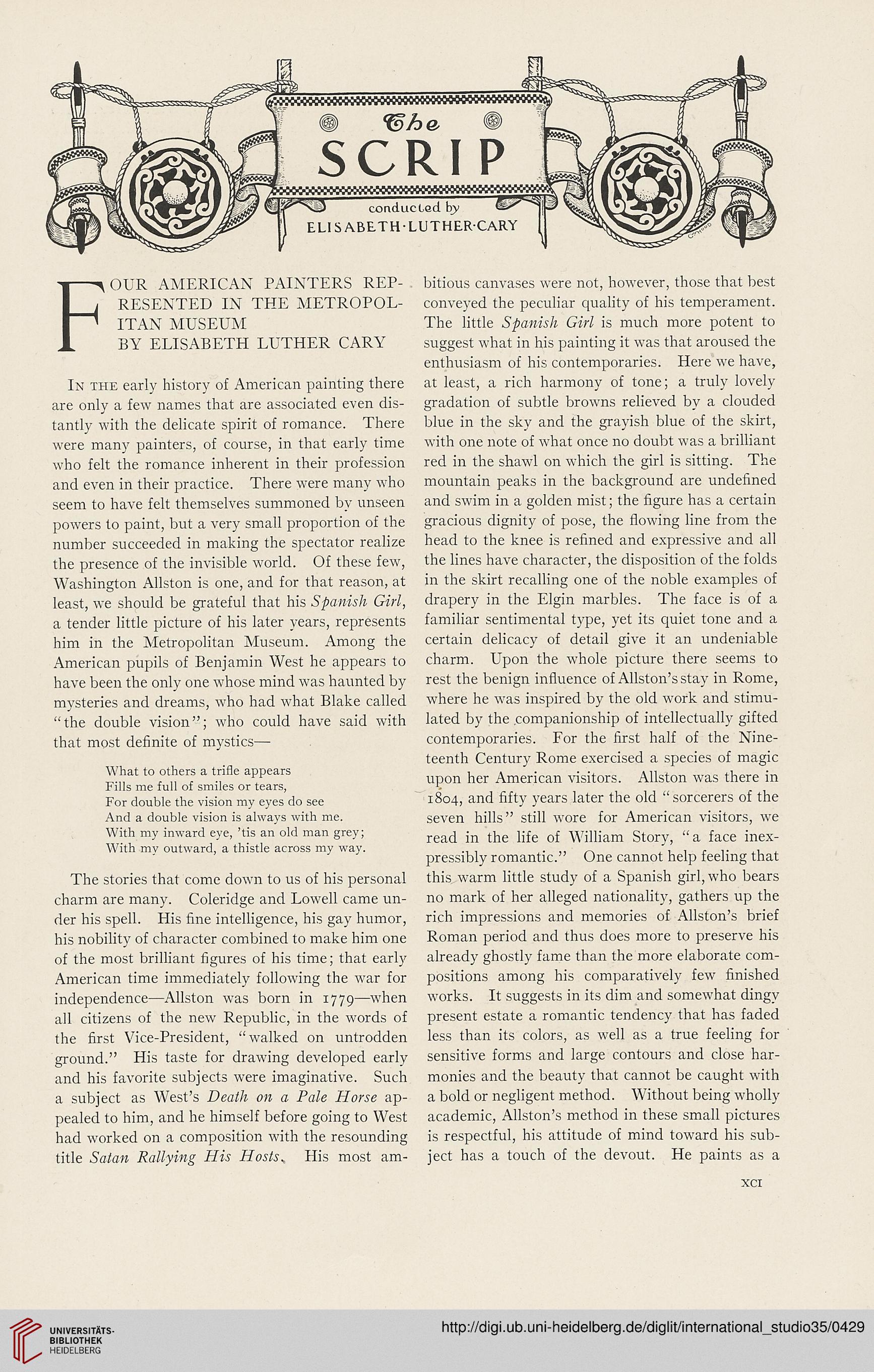OUR AMERICAN PAINTERS REP-
RESENTED IN THE METROPOL-
ITAN MUSEUM
BY ELISABETH LUTHER CARY
In the early history of American painting there
are only a few names that are associated even dis-
tantly with the delicate spirit of romance. There
were many painters, of course, in that early time
who felt the romance inherent in their profession
and even in their practice. There were many who
seem to have felt themselves summoned by unseen
powers to paint, but a very small proportion of the
number succeeded in making the spectator realize
the presence of the invisible world. Of these few,
Washington Allston is one, and for that reason, at
least, we should be grateful that his Spanish Girl,
a tender little picture of his later years, represents
him in the Metropolitan Museum. Among the
American pupils of Benjamin West he appears to
have been the only one whose mind was haunted by
mysteries and dreams, who had what Blake called
“the double vision”; who could have said with
that most definite of mystics—
What to others a trifle appears
Fills me full of smiles or tears,
For double the vision my eyes do see
And a double vision is always with me.
With my inward eye, ’tis an old man grey;
With my outward, a thistle across my way.
The stories that come down to us of his personal
charm are many. Coleridge and Lowell came un-
der his spell. His fine intelligence, his gay humor,
his nobility of character combined to make him one
of the most brilliant figures of his time; that early
American time immediately following the war for
independence—Allston was born in 1779—when
all citizens of the new Republic, in the words of
the first Vice-President, “walked on untrodden
ground.” His taste for drawing developed early
and his favorite subjects were imaginative. Such
a subject as West’s Death on a Pale Horse ap-
pealed to him, and he himself before going to West
had worked on a composition with the resounding
title Satan Rallying Plis Hosts, His most am-
bitious canvases were not, however, those that best
conveyed the peculiar quality of his temperament.
The little Spanish Girl is much more potent to
suggest what in his painting it was that aroused the
enthusiasm of his contemporaries. Here we have,
at least, a rich harmony of tone; a truly lovely
gradation of subtle browns relieved by a clouded
blue in the sky and the grayish blue of the skirt,
with one note of what once no doubt was a brilliant
red in the shawl on which the girl is sitting. The
mountain peaks in the background are undefined
and swim in a golden mist; the figure has a certain
gracious dignity of pose, the flowing line from the
head to the knee is refined and expressive and all
the lines have character, the disposition of the folds
in the skirt recalling one of the noble examples of
drapery in the Elgin marbles. The face is of a
familiar sentimental type, yet its quiet tone and a
certain delicacy of detail give it an undeniable
charm. Upon the whole picture there seems to
rest the benign influence of Allston’sstay in Rome,
where he was inspired by the old work and stimu-
lated by the .companionship of intellectually gifted
contemporaries. For the first half of the Nine-
teenth Century Rome exercised a species of magic
upon her American visitors. Allston was there in
1804, and fifty years later the old “sorcerers of the
seven hills” still wore for American visitors, we
read in the life of William Story, “a face inex-
pressibly romantic.” One cannot help feeling that
this, warm little study of a Spanish girl, who bears
no mark of her alleged nationality, gathers up the
rich impressions and memories of Allston’s brief
Roman period and thus does more to preserve his
already ghostly fame than the more elaborate com-
positions among his comparatively few finished
works. It suggests in its dim and somewhat dingy
present estate a romantic tendency that has faded
less than its colors, as well as a true feeling for
sensitive forms and large contours and close har-
monies and the beauty that cannot be caught with
a bold or negligent method. Without being wholly
academic, Allston’s method in these small pictures
is respectful, his attitude of mind toward his sub-
ject has a touch of the devout. He paints as a
xci




